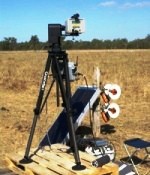
Researchers Use Open-path Lasers to Help Measure Methane from Herds
Technique said to be a "significant advancement" for determining greenhouse gas emissions from cattle.
Scientists have developed a methane release measuring technique to track the discharge of gas without disrupting the regular management of herds or large grazing animals. The technique is part of a collaborative research study conducted by researchers from Agriculture and Agri-Food Canada’s Lethbridge Research Centre, the Commonwealth Scientific and Industrial Research Organization, and the University of Melbourne in Australia.
Cattle were fitted with global positioning devices to track their movements, and wind speed and direction were constantly measured. Unlike previous studies in which a few cattle were handled daily and methane measurements were taken directly, this technique centered on using open-path lasers to obtain a short-term measurement of methane release from an entire grazing herd. For instance in one study, the technique was used to take repeated measurements of methane concentration every 10 minutes directly above the height of the 18 cattle in the paddock. According to the results, the technique developed so well it can account for 77 percent of methane release at a single point in a paddock.
Sean McGinn, the author of the study, describes the technique as a “significant advancement in assessing greenhouse gas emissions from the cattle industry.”
Collaborative research is continuing to further measure methane release from other agricultural sources. The full study is published in the January/February 2011 issue of the Journal of Environmental Quality.
The full article is available for no charge for 30 days following the date of this summary. Visit www.agronomy.org/publications/jeq/abstracts/40/1/22 for more information.
Source: Journal of Environmental Quality